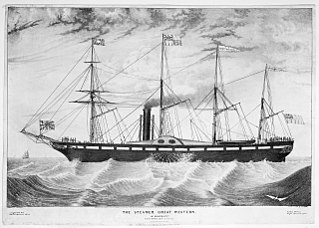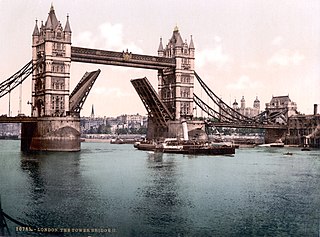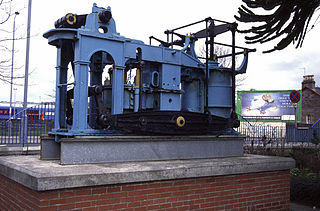
A steamship, often referred to as a steamer, is a type of steam-powered vessel, typically ocean-faring and seaworthy, that is propelled by one or more steam engines that typically move (turn) propellers or paddlewheels. The first steamships came into practical usage during the early 1800s; however, there were exceptions that came before. Steamships usually use the prefix designations of "PS" for paddle steamer or "SS" for screw steamer. As paddle steamers became less common, "SS" is assumed by many to stand for "steamship". Ships powered by internal combustion engines use a prefix such as "MV" for motor vessel, so it is not correct to use "SS" for most modern vessels.

A steamboat is a boat that is propelled primarily by steam power, typically driving propellers or paddlewheels. Steamboats sometimes use the prefix designation SS, S.S. or S/S or PS ; however, these designations are most often used for steamships.

A paddle steamer is a steamship or steamboat powered by a steam engine that drives paddle wheels to propel the craft through the water. In antiquity, paddle wheelers followed the development of poles, oars and sails, where the first uses were wheelers driven by animals or humans.

SS Great Western of 1838, was a wooden-hulled paddle-wheel steamship built of Dantzic pine, the first steamship purpose-built for crossing the Atlantic, and the initial unit of the Great Western Steamship Company. She was the largest passenger ship in the world from 1837 to 1839. Designed by Isambard Kingdom Brunel, Great Western proved satisfactory in service and was the model for all successful wooden Atlantic paddle-steamers. She was capable of making record Blue Riband voyages as late as 1843. Great Western worked to New York for 8 years until her owners went out of business. She was sold to the Royal Mail Steam Packet Company and was scrapped in 1856 after serving as a troop ship during the Crimean War.

PS Maid of the Loch is the last paddle steamer built in Britain. She operated on Loch Lomond for 29 years and as of 2019 is being restored at Balloch pier.
The shipping company is an outcome of the development of the steamship. In former days, when the packet ship was the mode of conveyance, combinations, such as the well-known Dramatic and Black Ball lines, existed but the ships which they ran were not necessarily owned by the organizers of the services. The advent of the steamship changed all that.

The Illawarra Steam Navigation Company was a shipping company that serviced the south coast of New South Wales, Australia from 1858 to the early 1950s. It was formed through the amalgamation of the General Steam Navigation Company, the Kiama Steam Navigation Company and the Shoalhaven Steam Navigation Company, each of whom serviced parts of the south coast with their respective vessels. After merging, the new company held a near monopoly in regard to shipping on the south coast, and their fleet visited every significant port between Sydney and the border of Victoria. The company transported both passengers and a range of produce, including livestock, and hence it became known as the 'Pig and Whistle Line': it was said that ships would wait an hour for a pig but not a minute for a passenger.
The West Cornwall Steam Ship Company was established in 1870 to operate ferry services between Penzance, Cornwall, and the Isles of Scilly. It became the West Cornwall Steamship Company in 1907 and was wound up in 1917.
George Forrester and Company was a British marine engine and locomotive manufacturer at Vauxhall Foundry in Liverpool, established by Scottish engineer George Forrester. The company opened in 1827 as iron founders and commenced building steam locomotives in 1834.

A steam yacht is a class of luxury or commercial yacht with primary or secondary steam propulsion in addition to the sails usually carried by yachts.

The Paddle steamship Stadt Rapperswil is the younger of the two remaining steam paddle ships on Lake Zürich. Stadt Rapperswil was built in 1914 by Escher, Wyss & Cie. in Zürich for the Zürichsee-Schifffahrtsgesellschaft. In contrast to most other Swiss paddle steamers, the most striking features of this vessel and its sister ship Stadt Zürich (1909) are a short smoke stack, and a spacious 1st class upper deck. The sister ships differ externally only minimally: In front, Stadt Rapperswil has a crossed flag mast. Her 1st class is more luxurious than her sister ship's, recognizable by mahogany and pear tree panelling, and an elaborate staircase to the upper 1st class deck.

RMS Atrato was a UK iron-hulled steamship. She was built in 1853 for the Royal Mail Steam Packet Company as a side-wheel paddle steamer, and at the time of her launch was the world's largest passenger ship. In 1870 RMSP traded Atrato in, causing her to lose the status of "Royal Mail Ship". She was converted to a single screw ship with a compound steam engine in 1872, and placed on the Aberdeen Line that chartered her to run to Victoria and New Zealand. In 1880 she was renamed Rochester before sinking four years later in 1884 by running aground.
The Drogheda Steam Packet Company was founded in 1826 as the Drogheda Paddle Steamship Co. It provided shipping services between Drogheda and Liverpool from 1825 to 1902, in which year it was taken over by the Lancashire and Yorkshire Railway.

Steamboat services started on the Thames in around 1815 and for nearly 25 years were the main use of steam to carry passengers before the emergence of railways in the south of England. During this time at least 80 steamers are recorded in the Thames and the Steamboat Act of 1819 became the first statute to regulate the safety of the new technology for the public. Wooden boats driven by paddle-wheels, they managed during this time to establish themselves as faster and more reliable than the earlier use of sailing and rowing boats for passenger transport within the Thames estuary.

Hyak was a wooden-hulled steamship that operated on Puget Sound from 1909 to 1941. This vessel should not be confused with the sternwheeler Hyak which ran on the extreme upper reach of the Columbia River at about the same time. The name means "swift" or "fast" in the Chinook Jargon.
William Patterson Shipbuilders was a major shipbuilder in Bristol, England during the 19th century and an innovator in ship construction, producing both the SS Great Western and SS Great Britain, fine lined yachts and a small number of warships.

Chasina was an iron-hulled, steam-powered ship, originally built as a steam yacht, but later converted to a passenger-freighter vessel that served in coastal British Columbia and other areas during the early decades of the 1900s under the ownership several different companies. The ship disappeared in 1931 after leaving Hong Kong.
John Duffus & Co., then George Duffus & Co. was an Aberdeen iron-works and shipbuilding company. The George Duffus company cast the iron parts for Shakkin' Briggie (1836), and also built Aberdeen's first paddle steamer, The Queen of Scotland (1827), the first steamship on the Aberdeen-London service. Duffus & Co. ceased business in 1846.

Messrs Robert Napier and Sons was a famous firm of Clyde shipbuilders and marine engineers at Govan, Glasgow founded by Robert Napier in 1826. It was moved to Govan for more space in 1841. His sons James and John were taken into partnership in 1853.
The Britannia of 1815 was a wood-hulled British paddle steamer built at Port Glasgow for services on the Firth of Clyde. Later she ran between Glasgow and Derry. Britannia was wrecked at Donaghadee on 12 October 1829.













